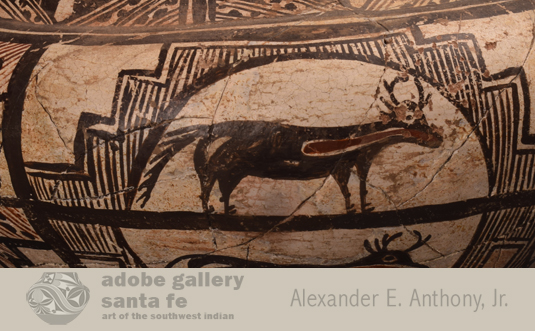Historic Kiapkwa to Zuni Polychrome Transitional Pottery OLLA [R]
+ Add to my watchlist Forward to Friend
Forward to Friend
- Category: Historic
- Origin: Zuni Pueblo, SHE-WE-NA
- Medium: clay, pigment
- Size: 9-3/4” tall x 13-1/4” diameter
- Item # C3504E
- Price No Longer Available
The middle of the 19th century saw changes occurring in Zuni pottery designs. Potters began to experiment with new designs that were more elaborate than previous ones. More surface of the vessel was filled with designs than previously. A puki impression is quite discernable on Zuni jars up until the 1920s at which time it generally was sanded off to provide a smooth transition from the lower- to mid-body. The neck design on early Zuni Polychrome jars was generally divided into panels rather than one continuous band. This jar has six panels, each with a red bird in the center and triangles with black dots in the four corners.
In transitional Kiapkwa Polychrome to Zuni Polychrome jars, the main body design was generally divided into two wide panels and two narrow panels, each divided by a wide vertical band. This jar is a typical Kiapkwa Polychrome to Zuni Polychrome transitional period jar—that is it probably dates from 1840 to 1860. After 1860, birds rarely, if ever, appeared in the neck design. The deer began to appear on the main body designs during the Kiapkwa Polychrome period in the 1840s and continued into the Zuni Polychrome eras.
This jar features more Kiapkwa Polychrome designs than seen on later Zuni Polychrome jars. The red birds on the neck and the division of panels on the main body, two of which feature heartline deer, are more typical of Kiapkwa Polychrome than of Zuni Polychrome. The narrow panels on the body repeat the basic design of each panel on the neck, with some changes. The rim is black and a wide black band extends about two inches down on the interior from the rim. The area below the body design is black below the puki line and the underside is concave. Interestingly, the deer have tails more like those of a horse than of a deer, but they have antlers so they are not horses.
Eventually, Zuni Polychrome designs developed differently from the Kiapkwa Polychrome designs. The birds on the neck migrated south and settled in a band between the upper and lower deer panels. A design resembling arrowheads replaced the birds on the rim. The heartline deer in the Kiapkwa did not have arrowheads at the end of the heartline, a change seen in the later Zuni Polychrome period. The fine black parallel lines surrounding the deer gave way to a solid block of design. The two narrow vertical body designs, between the larger deer designs, became a very standard design repeated in almost every Zuni Polychrome jar.
This is an extraordinary very old Zuni olla that is primitive in execution and painting, yet exciting to visual stimulation. It is a wonderful old jar in every respect.
Condition: the Historic Kiapkwa to Zuni Polychrome Transitional Pottery OLLA has been broken and reassembled without any attempt to conceal the breakage. UV examination does not reveal any plaster infill. It appears that all the shards were replaced without the necessity to fill voids with plaster.
Provenance: from the collection of a family who sold their Santa Fe residence and down-sized their collection of pottery.
Recommended Reading: The Pottery of Zuni Pueblo by Harlow and Lanmon
Relative Links: Zuni Pueblo, Native American Pottery

- Category: Historic
- Origin: Zuni Pueblo, SHE-WE-NA
- Medium: clay, pigment
- Size: 9-3/4” tall x 13-1/4” diameter
- Item # C3504E
- Price No Longer Available



